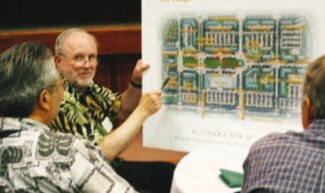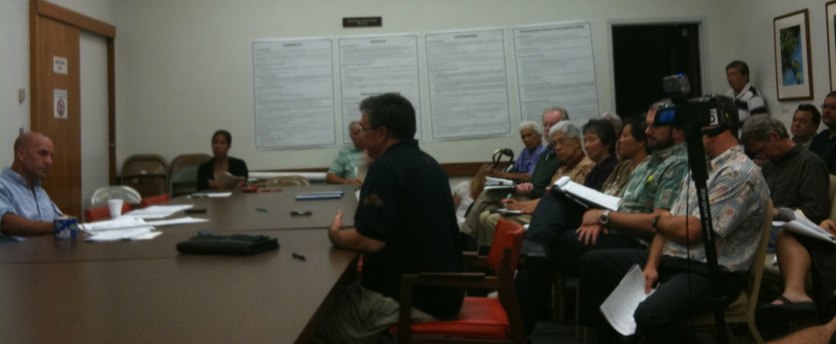Blog
News, updates, finds, stories, and tidbits from staff and community members at KAHEA. Got something to share? Email us at: kahea-alliance@hawaii.rr.com.
Farms, Not Dumps for Wai'anae Coast
Today, despite overwhelming community support for protecting local farm lands, developers are pushing Honolulu Councilmembers to approve a “purple spot,” a new industrial zone in the middle of green Lualualei Valley on the Waianae Coast.
Land Use Commissioners Approve Development on O'ahu Prime Ag Lands

From our friends and ‘ohana at Sierra Club Hawai’i Chapter:
In a 7-1 vote last week, the State of Hawaii Land Use Commission approved Castle & Cooke Homes Hawaii, Inc.’s proposed reclassification 767 acres of farmland to the urban district. Castle & Cooke proposes to build thousands of new homes and a medical complex at Koa Ridge between Mililiani and Waipio.
The Sierra Club, Hawaii Chapter, as a party to the case, asked the Commission to deny the reclassification because the project would adversely impact an already congested highway and prime agricultural lands.
“Castle & Cooke’s plan for Koa Ridge is the epitome of urban sprawl,” said Robert D. Harris, Director of the Hawaii Chapter of the Sierra Club. “When we’re importing 85 to 90% of our state’s food, it’s absurd to pave over land that has been consistently and profitably providing food for O`ahu.“
The Sierra Club brought expert witnesses before the Commission earlier in the year that testified about the detrimental impacts of losing nearly 800 acres of some of the best farmland in the state. Even Castle & Cooke’s own expert noted that the Koa Ridge proposal would develop approximately 5% of O`ahu’s remaining prime farmland (soil rated “A” and “B” under the ALISH system). The State Department of Agriculture testified that fifty percent of O`ahu’s prime farmland had been paved over in the past fifty years.
“Diversified agriculture increased 475% between 1990 and 2004,” said Harris. “There has been a resurgence of interest in eating in a local and sustainable manner. But if we want further growth in agriculture, we need to have the farmland.”
There are other anticipated demands on farmland, like growing bioenergy, which will require thousands of acres of farmlands with a ready supply of irrigable water. “It’s a slippery slope,” Harris continued. “As we develop more agricultural land, it drives up the cost for the remaining parcels and makes it more difficult for other farmers to grow local.”
One knowledgeable scientist testified that University of Hawaii faculty researchers are concerned O`ahu will lose its capability to feed itself unless large farmlands like Koa Ridge were preserved. “We’re just one hurricane away from starving,” said Harris. “We’re dangerously reliant on food from being shipped into O`ahu. Preserving and growing agriculture in the State is a matter of basic food security.”
Other witnesses testified about the surplus of land already proposed for development in Central O`ahu and the negative impact of increased traffic on folks traveling along the H-1 corridor. The state’s traffic expert testified that the peak “rush hour” traffic could extend bottlenecks on the H-1 freeway potentially from as early as 5:00 am in the morning and similar hours in the evening. The H-1 already has a grade “F” designation, the worst service traffic level.
The Sierra Club believes that the housing demand can be met without sprawling on more agricultural lands in Central O`ahu. Existing urban areas in Central O`ahu, such as Wahiawa and Waipahu, should be redeveloped. Further, over 13,000 units of housing have already been approved on over 1500 acres of agricultural land for new growth in Central O`ahu. Although the developer claims that new land must be developed to meet growing demand, population in some surrounding Central O`ahu communities actually decreased between 1990 and 2000.
“O`ahu is hitting some real limits to growth. We need to start redeveloping built areas instead of paving our finite and precious farmlands,” said Harris. “Particularly with plans for over 13,000 new housing units already on the books for Central O`ahu, it’s outrageous that the Commission would authorize new development of the best agricultural lands in the state.”
For more information, you can check out Sierra Club on the web at http://www.sierraclubhawaii.com/media.php
And here’s coverage from back in May of part of the LUC hearing on Koa Ridge: http://the.honoluluadvertiser.com/article/2010/May/21/bz/hawaii5210320.html
Ahi Feedlot Abandons Ship!

Mahalo to all who took action in the last few months, asking the Army Corps of Engineers to hold a public hearing on a permit to allow Hawai’i Ocean Technology, Inc. (HOTI) to build a proposed 247-acre ahi tuna feed lot off the Kohala Coast. 100% of the feed for this project would be imported from fisheries in places like Peru, and 90% of the tuna they feedlot will be exported to Japan and the continental U.S. (Does this sound like local food sovereignty to you? Not so much.)
Last week, we got news that HOTI has withdrawn their permit application. They may still be looking to do a smaller one-cage “experimental” operation. We’ll keep you updated. But for now, count this is a victory for the ocean. Mahalo for your action! Thanks to you, we’re a little closer today to a collective vision of food sovereignty and a functioning food system for Hawai’i. To learn more or to join the hui in support of pono aquaculture, you can go to www.ponoaqua.org
Laughable public process: changes to conservation protections

Hearings officer Sam Lemmo, the administrator for OCCL, made a point of assuring the room that the final regulations would definitely be different from what we are seeing tonight based on all of the great input they had been getting. (Did you just feel that gentle pat on the top of your head? I did.)
We pressed Sam on when we might actually see the final regulations. Generally speaking, the agenda for the Board of Land and Natural Resources is posted a mere six-days before the Board decides an issue. Will we only get six days to review the final version of the rules that are supposed to be protecting our conservation lands for at least the next 15 years?
In response, Sam chuckled and said “good question.” The audience laughed. I laughed, too — because what do you do when someone laughs in your face? Despite all the laughter it was a sad moment.
It is sad when regulations as important as these are given but the bare minimum of study and public process. We are talking about 2 million acres of conservation lands — our watersheds, nearshore waters… the important places. Conservation lands are 51% of the crown and government lands that are supposed to be held in the “ceded” lands trust for Native Hawaiians and the people of Hawaii — we have an obligation to protect these assets.
From what I hear from the old-timers, when these rules were changed 15 years ago, there was a public blue ribbon panel convened to advise the division on improving the regulations. Today, DLNR is unilaterally proposing major revisions. What gives? Where is the expert panel? The thoughtful study? The reasoned assessment?
In response to my quote on the need for “a blue ribbon panel” in the Star-Advertiser on Thursday, several insiders came forward at the hearing to thank Sam for DLNR’s history of work on these rule changes that were, in their words, “a long-time coming.” So long in coming, in fact, that the public just heard about them. These rules saw the first light of day in July and are expected to be approved before December. Coincidentally, that’s right before the Lingle Administration leaves office. Feels more like a 50-yard dash than a “long-time coming” to me.
Both in and out of public hearings, we have heard Sam say, at least 20 times (no exaggeration, I seriously counted), “Good question, that wasn’t what I intended” in response to questions and concerns about the staff’s proposed changes. I don’t know about you guys, but if what I write down isn’t what I meant to say, its usually because I was in a rush and didn’t take the time to think about the implications… welll… that kind of pondering is exactly what we need right now.
Good changes, bad changes, the bottom line is these changes need more thought. We should not let the timeline for the end of an administration drive the schedule for amending some of the most important protections in our islands.
Want to feel like you were there? Here is a link to notes from the Honolulu public hearing on August 12, 2010.
Want to participate in the process? Sign up for KAHEA’s action alert network, later this week we’ll send out an easy-to-use comment form by email.
Signs of Aloha Aina
From Marti:
We had our first sign-making party in the “Keep Waianae Country” effort. We are getting ready for the Land Use Commission to visit the parcel of farmland that Tropic Land proposes to turn into an industrial park. Their visit happens on Wednesday August 18th at 1:30 pm.
Want to join us? We’ll be on Farrington Highway where it intersects with Lualualei Naval Access Road and with Hakimo Road at 1:00 pm.
Can’t make it, but still want to participate? Then make a sign in support of keeping Waianae country, take pictures of you and your friends holding the sign, and then send the pictures to us at miwa(at)kahea.org. We’ll make sure the LUC sees it.
And if you live along the navy road or Hakimo road, then hang a sign on your fence where everybody can see it. We’ll be passing out the beautiful signs we made next week. Let us know if you want one.
Big Mahalo to everyone who came out to help us make signs. It was a lot of fun. And who knew Tyler would turn out to be poster-painter extraordinare… in addition to top ace legal intern?! Finger painting ain’t just for kids anymore!
Collaborate Much?

We’re liking this thought-proving post from journalist Anne Minard, on the “next great telescope race”–Day 14 of her “100 Days of Science.” She asks some great questions about the fundamental purpose of the two U.S. proposals for “next generation” giant land-based telescopes being proposed for construction within the next 10 years. Do we really need THIS much telescope, guys?
Charles Alcock, director of the Harvard-Smithsonian Center for Astrophysics, acknowledged that the two telescopes are headed toward redundancy. The main differences, he said, are in the engineering.
He said the next generation of telescopes is crucial for forward progress in 21st Century astronomy.
“The goal is to start discovering and characterizing planets that might harbor life,” he said. “It’s very clear that we’re going to need the next generation of telescopes to do that.”
And far from being a competition, the real race is to contribute to science, said Charles Blue, a TMT spokesman.
“All next generation observatories would really like to be up and running as soon as possible to meet the scientific demand,” he said.
But when I asked him why the United States teams haven’t pooled their expertise to build a single next-generation telescope, Blue declined to comment.
In all, there are actually three teams (two from the U.S., and one from Europe) racing to build the first of these giant land-based telescopes: Extremely Large Telescope (Europe), TMT (U.S.), and Giant Magellan Telescope (U.S.). (And no, we’re not making these names up… in almost every description we could find, these bad boys are characterized first and foremost by their massive size.) The total estimated price tag for all this summit development? $2.6 billion dollars.
In the midst of this competition to build the first and the largest, the worldwide community of those who share aloha for sacred summits are humbly asking: for time and real consideration for native ecosystems, threatened endemic species, the cultural meaning of sacred space, cultural practice, and the natural and cultural heritage we have to pass forward to next generations… all in short supply on earth today. Can we not rationally slow down this latest race for space, in the interest of the future of life on our own planet?
Exemptions Gone Wild
Generally, under today’s environmental laws, certain kinds of projects have to do an environmental review (Like an EIS). Other kinds of projects can be exempted. The BP oil spill at Deepwater Horizon has been a sobering reminder of why these kinds of environmental reviews and exemptions are so critical. (Can you believe THIS was exempted from EIS?)

Today, DLNR is proposing a “wild laundry list” of EIS exemptions for DLNR-managed lands, from building new roads to chemical herbicides. That’s 57 pages (fifty-seven!) of exemptions. Yeesh. We are asking the Office of Environmental Quality and Control (OEQC) to send DLNR back to the drawing board. If you or your organization is interested in participating in a group letter to OEQC or just want to know more about this issue, please contact Marti at marti@kahea.org by Friday morning.
















